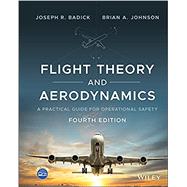FLIGHT THEORY AND AERODYNAMICS
GET A PILOT'S PERSPECTIVE ON FLIGHT AERODYNAMICS FROM THE MOST UP-TO-DATE EDITION OF A CLASSIC TEXT
The newly revised Fourth Edition of Flight Theory and Aerodynamics delivers a pilot-oriented approach to flight aerodynamics without assuming an engineering background. The book connects the principles of aerodynamics and physics to their practical applications in a flight environment. With content that complies with FAA rules and regulations, readers will learn about atmosphere, altitude, airspeed, lift, drag, applications for jet and propeller aircraft, stability controls, takeoff, landing, and other maneuvers.
The latest edition of Flight Theory and Aerodynamics takes the classic textbook first developed by Charles Dole and James Lewis in a more modern direction and includes learning objectives, real world vignettes, and key idea summaries in each chapter to aid in learning and retention. Readers will also benefit from the accompanying online materials, like a test bank, solutions manual, and FAA regulatory references.
Updated graphics included throughout the book correlate to current government agency standards. The book also includes:
- A thorough introduction to basic concepts in physics and mechanics, aerodynamic terms and definitions, and the primary and secondary flight control systems of flown aircraft
- An exploration of atmosphere, altitude, and airspeed measurement, with an increased focus on practical applications
- Practical discussions of structures, airfoils, and aerodynamics, including flight control systems and their characteristics
- In-depth examinations of jet aircraft fundamentals, including material on aircraft weight, atmospheric conditions, and runway environments
- New step-by-step examples of how to apply math equations to real-world situations
Perfect for students and instructors in aviation programs such as pilot programs, aviation management, and air traffic control, Flight Theory and Aerodynamics will also appeal to professional pilots, dispatchers, mechanics, and aviation managers seeking a one-stop resource explaining the aerodynamics of flight from the pilot's perspective.








